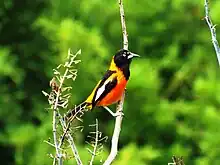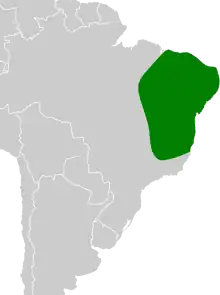Campo troupial
The campo troupial or campo oriole (Icterus jamacaii) is a species of bird in the family Icteridae that is found in northeastern Brazil. At one time thought to be conspecific with the Venezuelan troupial and orange-backed troupial, it is now accepted as a separate species. It is a fairly common bird and the International Union for Conservation of Nature has rated it as a "least-concern species".
| Campo troupial | |
|---|---|
 | |
| Scientific classification | |
| Domain: | Eukaryota |
| Kingdom: | Animalia |
| Phylum: | Chordata |
| Clade: | Dinosauria |
| Class: | Aves |
| Order: | Passeriformes |
| Family: | Icteridae |
| Genus: | Icterus |
| Species: | I. jamacaii |
| Binomial name | |
| Icterus jamacaii (Gmelin, 1788) | |
 | |
Name
The term troupial is from French troupiale, from troupe (“troop”), so named because they live in flocks.[2] The Latin name icterus is from Greek ἴκτερος (íkteros, “jaundice”); the icterus was a bird the sight of which was believed to cure jaundice, perhaps the Eurasian golden oriole.[3] It also had the more general meaning "yellow bird", which is why the name was later given to this and other New World orioles.[4] Campo refers to a grass plain with semi-stunted trees. The specific name jamacaii comes from the name used for this species by Georg Marcgrave in the 1648 work Historia Naturalis Brasiliae;[5] it may have been a Tupi word for this or another small black-and-yellow bird, or it may have been applied to the species by Portuguese settlers.[6][7] Additional names used for this species in the 1800s include black-banded troupiale, soffre, and (erroneously) Jamaica yellow bird.[8][9]
Description
The campo troupial is very similar in appearance to the Venezuelan troupial (Icterus icterus) with which it was at one time thought to be conspecific. It is a robust bird about 23 cm (9 in) long with a long tail and a broad beak. It is bright orange apart from a black hood and bib, back, wings and tail. There is an uneven line dividing the bib from the breast. It differs from the Venezuelan troupial in having only a small patch of white on its wings and hardly any bluish skin around its eye, and it has orange epaulettes on its shoulders whereas the Venezuelan bird does not. It could also be confused with the orange-backed troupial (Icterus croconotus), with which it was also once considered conspecific, but that species has an orange head apart from a patch of black on its forehead, a sharp dividing line between its bib and its breast, and rather more orange on its back.[10]
Distribution and habitat
The campo troupial is endemic to northeastern Brazil, where its area of occurrence is estimated to be over 2,000,000 square kilometres (770,000 sq mi).[1] It typically inhabits dry scrubland and deciduous woodland, at elevations up to 700 m (2,300 ft) or more. The ranges of the Venezuelan troupial, the campo troupial and the orange-backed troupial do not overlap.[10]
Ecology
The diet consists of insects and other small invertebrates, fruits and nectar; one individual was found to have 126 fly larvae in its stomach.[11] Breeding takes place during the wet season, between December and March.[11]
Status
The campo troupial is a fairly common bird with a wide range and the population seems to be stable. For these reasons, the International Union for Conservation of Nature has rated its conservation status as being of "least concern".[1]
References
- BirdLife International (2018). "Icterus jamacaii". IUCN Red List of Threatened Species. 2018: e.T22724120A132026482. doi:10.2305/IUCN.UK.2018-2.RLTS.T22724120A132026482.en. Retrieved 17 November 2021.
- "Definition of TROUPIAL". www.merriam-webster.com.
- "Charlton T. Lewis and Charles Short: A Latin Dictionary (1879)". Oxford: Clarendon Press. Retrieved 15 October 2021.
- "Definition of Icterus". MedicineNet.
- Marcgrave, Georg (1648). Historia Naturalis Brasiliae (in Latin). Vol. Liber Quintus: Qui agit de Avibus. Lugdun and Batavorum (London and Leiden): Franciscum Hackium and Elzevirium. p. 198.
- Jobling, James A. (2010). The Helm dictionary of scientific bird names: from aalge to zusii. London: Christopher Helm. p. 210. CiteSeerX 10.1.1.695.7104. ISBN 978-1-4081-3326-2. OCLC 659731768.
- Jobling, J.A. (2020). "Key to Scientific Names in Ornithology". In del Hoyo, J.; Elliott, A.; Sargatal, J.; Christie, D.A.; de Juana, E. (2020) (eds.). Handbook of the Birds of the World Alive. Barcelona: Lynx Edicions. Retrieved 29 March 2020.
- Studer, Jacob Henry (October 2, 1878). "Studer's Popular Ornithology ..." J.H. Studer & Company – via Google Books.
- Jones, Thomas Rymer (August 3, 2020). Cassell's Book of Birds: Volume 1. BoD – Books on Demand. ISBN 9783752398700 – via Google Books.
- Ridgely, Robert S.; Tudor, Guy (2009). Field Guide to the Songbirds of South America: The Passerines. University of Texas Press. p. 672. ISBN 978-0-292-71748-0.
- Fraga, R (2017). "Campo Troupial (Icterus jamacaii)". Handbook of the Birds of the World Alive. Lynx Edicions, Barcelona. Retrieved 17 October 2017.
